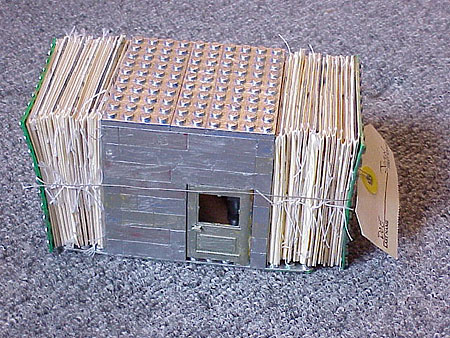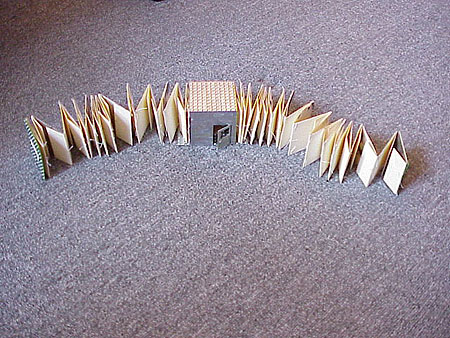
ABSTRACT:
The detention center I interned at is an alternative to jail and a temporary holding center for juveniles. This detention furnishes secure accommodations for youth that are awaiting adjudication of their cases by the Juvenile Division of the Circuit Court. The population is disproportionately male, economically disadvantaged, and members of racial and ethnic minorities. The ages range from ten to twenty-one years. This center typically houses 400 - 500 juveniles at one time. With twenty admissions each day, nine thousand juveniles go through the detention center in one year.
Interactions with incarcerated youth are brief because of the overcrowded system and the restrictive nature of working within a correctional facility. It became apparent that the individuals had less empathic ways of working. Early on in my art therapy internship, I began to question if these less empathic encounters were a deliberate and conscious choice by the individuals who work with detained youth. If this were true, would I someday be making the same calculated, conscious choice?
My curiosity, wonder and yearning for something different lead me to a deliberate and conscious choice to find empathic approaches using art therapy in a correctional facility. My thesis concentrates on the process in which empathy is attainable in a challenging environment. I chose creative writing as the format of my post-session response art because it deepened my experience of empathy toward both my client and myself and helped me evaluate how empathic my responses actually were throughout those brief therapeutic encounters.
BIOGRAPHY:
In May 2000, I graduated from the School of the Art Institute of Chicago with a Masters of Art in Art Therapy (MAAT). Diversifying my education, I chose to do an overseas study as an Associate Graduate student at Goldsmith College University of London in their Postgraduate Diploma in Art Psychotherapy. I obtained her BS in Graphic Design, Child & Family Studies, Arts & Letters, Social Sciences with a minor in Psychology at Portland State University in 1998. I am interested in promoting social action in the area of violence prevention and intervention using artistic expression.

Untitled
(2000) Staci Martin (Response piece to Detention Center, closed)
ART WORK:
At the detention center "Z" (pseudonym) and I built a 3-dimensional structure that signified the city of Chicago during one of our individual sessions. All he wanted me to say about his art was "It all has something to do with what he is thinking about." His comment seemed to resonate with my own process of art making.
My response to "his city of Chicago" was to build a 3-dimensional structure that signified the space that he temporarily lives in, a cell. This cell also is where we have individual art therapy sessions. On each side of the cell walls are narratives. These narratives are in response to the Detention Center as a whole. One narrative is of my journey at my internship and on the other side is a compilation of many stories that I have heard from detained youth. In order to understand the magnitude of what a child goes through I have decided on using one narrative. This does not encompass all the variables because each case is unique to the individual. However, I hope the reader can gain a glimpse of what the child might be feeling. The reader will notice that the following is the same time-frame as my own narrative, only from the detained youth's perspective.

Untitled
(2000) Staci Martin (Response piece to Detention Center, opened)
MY JOURNEY: DIARY OF A DAY I:
It is 5:30 a.m. and my radio blares with National Public Radio telling me the national and local news, weather and traffic. I scramble to get up because this is the third time I pushed snooze. I have a half an hour to get ready to catch the #12 bus on Roosevelt Street, four blocks from my home in Chicago, Illinois.
It is 6:15 a.m. and the bus is late again. My bus goes straight down Roosevelt Street towards the out skirts of University of Illinois at Chicago's campus. Finally, we stop at my destination. I venture out of the bus into the early morning. Cars whiz by me and I am still half-asleep. The detention center is an oversized white building that takes up a square block. On the eastside of the building, I go into the revolving doors; two officers in blue greet me. I suspect they are also half-asleep. I show my tattered letter that I received in August from my supervisor. It says that I will be attending psychology internship at detention center through May of 2000.
It is 6:45 a.m. and I am sitting in the waiting area on the second floor where juveniles are taken to start the process of detainment at detention center. It is quiet and only a handful of people are in the waiting area. My supervisor shows up. He is a large man and animated in his demeanor. He does his morning routine of clocking in, picking up the mail and seeing if we have any new intakes. We take an elevator up to the third floor and walk through the medical isolation unit. Talking as he walks, he recaps the highlights of the weekend. Attempting to catch up with his words and his footsteps, finally I rest in the psychology office for 5 to 10 minutes until he is ready to go again.
It is 6:55 a.m. and I am peering out of the door that opens to the long cement hallway. Cell doors are locked. The children are asleep. In a couple of hours, they will be awake and the silence that was once before will be no longer.
It is 7:00 a.m. my supervisor is talking to me as his back is to me. He is typing on his computer. He grabs the folders and is ready to go. We will be doing the fifth floor. It is a peculiar thing to do, but he stares out the window and identifies the puffy clouds for me. He forecasts the weather for the day.
It is 9:00 a.m. and within two hours I have seen about 150 youth. I actually speak with and assess about twenty to thirty youth who are on either Close Watch or Follow-Up. Along with that, I followed up on two Juvenile Mental Health Screening Forms.
It is 9:05 a.m. and the faces of the youth seem to blur. I am trying to keep their names down but it is a lost cause. The one thing that sticks out in my mind is my rambling out assessment questions. Some kids have the answers memorized. When's your next court date? What do you expect the outcome will be? Do you have thoughts of hurting yourself? It has almost become a mantra.
It is 9:15 a.m. and my supervisor just got his morning coffee and breakfast from the cafeteria on the second floor. I open a can of Coca-Cola. Until 12:00 p.m. in their cells, I have the opportunity to see clients in the medical unit and do one to one art therapy. I pray as I go in the cell, for the safety of the child and myself. Trusting that the child has enough strength to plow through issues, that I have enough strength to stay with them in their cell.
It is 12:15 p.m. and I attempt to see a child on a section. Between 11:45-12:30 p.m. the youth are back from the alternative school for a lunch break. I am unable to see the child because of various circumstances: I don't have my own set of keys; my supervisors have to go somewhere and I have to go with them; or there is a crisis.
It is 12:30 p.m. and I am eating lunch with both my supervisors on the second floor cafeteria. One of my supervisors told me lunches are free to all staff. This is so no one will leave the building for lunch. The thought was that it would help with security factors and allow breaks for staff.
It is 1:00 p.m. and I am sitting among staff members in the alternative school for a behavior modification meeting. I just passed several kids in the hall. A fight had just been broken up. This meeting is to talk about the behavior modification program, but turns out to be more of a group therapy for staff. It is a safe place for the staff to express their frustrations about the institution, children and their own feelings of insecurity. The more I listen, the more I would like to start an art therapy support group.
It is 1:55 p.m. and I go to Floor 3, Section B to run my intake art therapy group. This lasts for an hour. I have eight clients. I am overwhelmed and I wish someone would leading it with me. The clients amaze me. I am grateful for their spirit and patience with an art therapy intern.
It is 2:55 p.m. and I am back at the Psychology office. I choose not to talk about the group. I figure that can wait until tomorrow. I need some time to absorb the group so I can articulate my feelings and thoughts. Either one of my supervisors escort me down to the second floor where I started my day. The atmosphere has changed. It is noisy. Lawyers, parents and caseworkers are waiting. Down a flight of the stairs and officers in blue greet me and I leave the building. I wait for the bus and take a deep breath.
It is 3:15 p.m. and I am sitting on the bus. I am flooded with sounds, images and feelings. I remember faces, but I have problems remembering names. I am not sure if this is because I see so many people in one day or if it allows me to distance from my clientele. All I know is each day I recall the clients' faces that have taught me something, and I am thankful. At times, I get frustrated because the probabilities of seeing a client twice is next to nil. Daily I make peace with this frustration, knowing that I can only do so much in one day. The bus stops and I go home.
It is 3:20 p.m. and I am home.
COMPOSITE JUVENILE OFFENDER'S PERSPECTIVE: DIARY OF DAY II:
This narrative is a compilation of many stories that I have heard. In order to understand the magnitude of what a child goes through, I have decided to use one narrative. This does not encompass all the variables because each case is unique to the individual. I hope the reader can gain a glimpse of what the child might be feeling. The reader will notice that the following is the same time frame as the above narrative, only from the juvenile offender's perspective.
It is 5:30 a.m. and this was my third night in the Audy Home. Last time, I was brought into detention center on a court order, but this time it was because of an arrest. I received a detention hearing within forty-eight hours of my arrest. The alleged charges were heard. There was substantial evidence found and the court ordered me to stay at the Audy Home for several days. Thereafter, I am at the mercy of the court. I am uncertain where I might be going. The last time I was here, there was no substantial evidence and I was released to go home.
It is 6:15 a.m. and my neighbors are still sleeping. I am unable to sleep. I am worrying about my court date. I do not know what I am going to do. I am stressed.
It is 6:45 a.m. and my mind is going wild. Will my peers accept me? I fear personal violence from other inmates. Last time . . . last time, I don't want to think about last time.
It is 6:55 a.m. and my door will be unlocked soon. During intake, I surrendered all my personal possessions. Now they are housed in a paper bag with my name and section number on it. I have to wear a uniform. I am told when I can take a shower and I have to ask permission if I can go to the bathroom. I feel scared and I am not sure if I can take this any longer. I am anxious and I did not sleep well. The kid next to me would not shut up.
It is 7:00 a.m. and my cell is a small room with four brick walls. There is one door that has a full-length window in the middle of it. The room has a small metal toilet and sink unit. Toilet paper is rationed. A window sits under the high ceiling of one of my walls. I get in trouble when I stand up on my bed to look out. Freedom. I have a couple of blankets, but I want my comforter from home. I have little privacy. It is cold. I have no control if I want the light on or off. I have no control who enters my room. Since I am new, I am on level 1. What is the point of making it to level two when you can have it taken away from you just like that.
It is 9:00 a.m. and I am waiting in line for school. This morning I was assessed by a woman from the psychological services. One of her questions was, "Have I been crying?" Secretly I wanted to tell her, "Yes" but then I would be seen as weak or worst yet, I would be jumped by kids who overheard us talking. I would have told her if I could trust her. I wanted to tell her I missed my family and wanted out. I wanted to tell her how hard it is to live here. But I did not.
It is 9:05 a.m. and I am angry. I am angry that I have to be trapped in this place. It is hot in this section, but I get so cold walking down the hall. I need to get out of here.
It is 9:15 a.m. and I am sitting in class. The teacher is saying something, but I cannot understand. Who cares about school? I can feed my family with what I can make off the street. It's about survival out there.
It is 11:45 a.m. and lunch is served. I cannot talk during lunch and I have to do whatever chores the attendants assign me to do. I cannot talk when we are watching television. I am being watched all the time. I feel like I am being controlled.
It is 12:30 p.m. and at school I have small classes, but I am having a hard time concentrating. I feel like I might explode. All I can think about is my family needs me and here I am. Who is going to protect my mother and siblings?
It is 1:00 p.m. and I swear I did not do what the police accused me of doing. I was just at the wrong place at the wrong time. I need to talk to my caseworker or parole officer.
It is 1:55 p.m. and I am scared.
It is 2:55 p.m. and I am afraid someone is going to hurt me. If someone lays a hand on me, I will fight back. No one can touch me.
It is 3:15 p.m. and I am back to the section. I am bored. At home, it is different. Now, I need to find out a way to pass time. When is dinner? I want to go to bed.
It is 3:20 p.m. and I just want to go home.
CONCLUSION:
Even though this was a difficult internship and less than ideal situation, the experience of writing this thesis and the internship validated and reinforced the reasons to do art therapy in detention centers. Art therapy is one of few modalities within the detention center that could foster hope and create empathic connections.
I do not know who originally coined the word "social pathology." I found the terminology in Campbell and Abra Gaga's (1997) article, "Black on Black Art Therapy: Dreaming in Colour." I subscribe to the notion and philosophy that social pathology exists. I believe social pathology affects individual pathology and have witnessed these effects in many of the youths at the detention center. I always thought about difficult questions concerning human suffering.
I do not have the answers on how one might go about creating a more empathic society. However, if I learned anything from this internship, it was that I want to move forward with my focus on the prevention of social pathology. I am willing to devote much of my time to seek out those difficult answers.